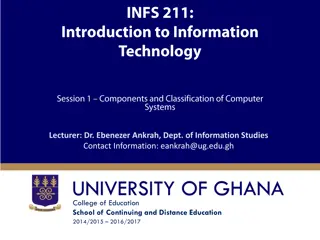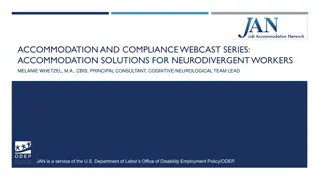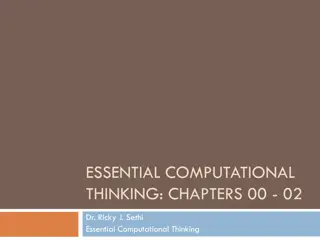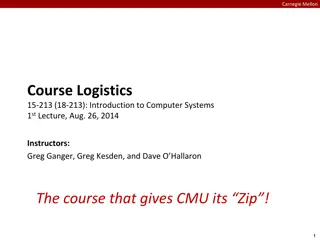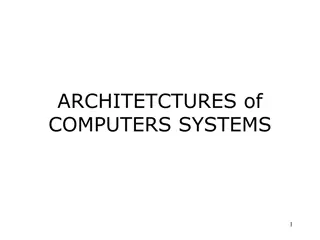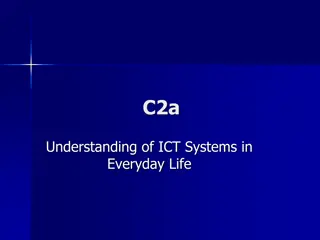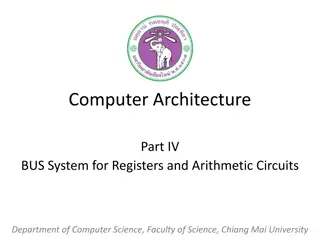Understanding Computer-Based Information Systems (CBIS)
Computer-Based Information Systems (CBIS) transform raw data into valuable information to support decision-making, coordination, and control. CBIS utilize computers to collect, process, analyze, and distribute information efficiently. Data is the raw material, while information is the processed data that aids in operations and decision-making within organizations.
Download Presentation

Please find below an Image/Link to download the presentation.
The content on the website is provided AS IS for your information and personal use only. It may not be sold, licensed, or shared on other websites without obtaining consent from the author. Download presentation by click this link. If you encounter any issues during the download, it is possible that the publisher has removed the file from their server.
E N D
Presentation Transcript
Computer Based Information Systems (CBIS CBIS)
Introduction CBIS is a data processing system into a high-quality information and can be used as tools that support decision-making, coordination and control as well as visualization and analysis. Some terms related to CBIS include: DATA INFORMATION SYSTEMS INFORMATION SYSTEMS COMPUTER BASE
Data Data is a collection of raw, facts and figures. The word raw means that the facts have not yet been processed. It may be consist of numbers, characters, symbols or picture. EXAMPLE: Student fill an admission form when they get admission in college or university. The form consist of raw facts (student s name, father name, address etc.) The purpose of collecting this data is to maintain records of the students during study period.
Information Processed data is called information. When raw facts and figures are processed and arranged in some order then they become information. Information is useful in decision making. Actually we process data to convert it into information. It is more meaningful than data. EXAMPLE: If we want to know about the student who is outside from the Lahore then can be found by some processing and this processed data is information.
System System is a set of elements or components that interact with one another to achieve a common goal. Systems are entities, both abstract and concrete, which consists of several interrelated components to each other: Input (commands you enter from the keyboard to data from another computer or device) Processing (Movement of data or material towards a known goal or end result) Output(A result produced by a computer ) EXAMPLES: An examination system A billing system
Information System It is an integrated set of components for collecting, storing, and processing data and for delivering information, knowledge, and digital products. Business firms and other organizations rely on information systems to carry out and manage their operations, interact with their customers and suppliers, and compete in the marketplace. Functions of information system: Input : Facts or data from outside the system Processing : Transform the data to information Output : Information that need to be used outside the system Storage : A place to store data for future reference
CBIS In Information Systems' computer-based "means that the computer plays an important role in an information system. A computer based information system, or CBIS, uses computers to collect, process, store, analyze and distribute information for a specific purpose, such as meeting a business objective.
Elements of CBIS Computer Based Information System (CBIS) is an information system in which the computer plays a major role. Such a system consists of the following elements: Hardware Software Data Procedure People
Elements of CBIS HARDWARE The term hardware refers to machinery. This category includes the computer itself, which is often referred to as the central processing unit (CPU), and all of its support equipment. Among the support equipment are input and output devices, storage devices and communications devices.
Elements of CBIS SOFTWARE The term software refers to computer programs and the manuals (if any) that support them. Computer programs are machine-readable instructions that direct the circuitry within the hardware parts of the Computer Based Information System (CBIS) to function in ways that produce useful information from data. Programs are generally stored on some input / output medium often a disk or tape.
Elements of CBIS DATA Data are facts that are used by program to produce useful information. Like programs, data are generally stored in machine readable form on disk or tape until the computer needs them. It may be consist of numbers, characters, symbols or picture.
Elements of CBIS PROCEDURES Procedures are the policies that govern the operation of a computer system. Procedures are to people what software is to hardware is a common analogy that is used to illustrate the role of procedures in a CBIS.
Elements of CBIS PEOPLE People are required for the operation of all information system. Every Computer Based Information System (CBIS) needs people if it is to be useful. Often the most over-looked element of the CBIS is the people. probably the components that most influence the success or failure of information system.
TELECOMMUNICATIONS Electronic transmission of signals for communications and enables organizations to link computer systems into effective networks. Strategic Use Of Information Technology The role of information and information systems has changed dramatically in the past last twenty years. The adoption of computer based information systems have strategic consequence for organizations. The information systems perform four major roles in an organization: support of business operations, support of management decision making, support of management control and support of strategic organizational advantages.
Types of Computer Based Information Systems Management Support System Management Information System Decision Support Systems Executive support system Expert System Transaction Processing Systems Office Automation Systems Accounting Information System
Expert System An expert system is an information system that captures and stores the knowledge of human experts and then imitates human reasoning and decision making. Expert system consist of two main components: Knowledge Base: It is a database that contains facts provided by a human expert and rules used by the expert system to make decision. Inference Engine: It is a software program that applies the rules to data stored in the knowledge base to reach decision.
Management Support System There are three generic kinds of management support systems: Management information systems Decision support systems Executive support systems
MANAGEMENT INFORMATION SYSTEM Data processing by computers has been extremely effective because of several reasons. The main reason being that huge amount of data relating to accounts and other transactions can be processed very quickly. MIS are more concerned with management function. MIS can be described as information system that can provide all levels of management with information essential to the running of smooth business. A management information system is an information system that generates accurate, timely and organized information for decision making.
The information can be used by managers and other users to make decision and solve problems. This information is used by related management information system to produce reports of daily sales activities and prepare list of customers with due account balance. EXAMPLES: Sales management Inventory control Capital investment analysis
DECISION SUPPORT SYSTEM A decision support system helps users to analyze the information and make decision. Decision support system may include data from internal source (TPS,MIS) or external source. Decision makers use Decision Support System to design decision models. Decision model is a numerical representation of a realistic situation such as cash flow model of a business that shows how income adds to cash accounts and how expense deplete accounts.
COMPONENTS OF DSS Inputs User knowledge and Expertise Outputs Decision Example: Analyzing the effects of events such as strikes, rising interest rates, etc.
Executive support system An executive information system (EIS), also known as an executive support system (ESS) is a type of management information system that facilitates and supports senior executive information and decisionmaking needs. It provides easy access to internal and external information relevant to organizational goals. These systems were mainframe computer-based programs. The purpose was to package a company s data and to provide sales performance or market research statistics for decision makers, such as marketing directors, chief executive officer, who were not necessarily well acquainted with computers.
TRANSACTION PROCESSING SYSTEM (TPS) A transaction is an exchange between two parties that is recorded and stored in a computer system. A transaction processing system is an information system that provide a way to collect, process, store, display, modify or cancel transaction. Data collected by TPS stored in database. Example: The process of buying and selling a product The process of withdrawing cash from an ATM.
Office Automation System (OAS) Office Automation Systems are among the newest and most rapidly expanding computer based information systems. They are being developed with the hope and expectation that they will increase the efficiency and productivity of office workers, typists, secretaries, administrative assistants, staff professionals, managers and others. Examples: Introducing new products, starting a company wide cost control program, etc.
ACCOUNTING INFORMATION SYSTEMS (AIS) The collection, storage and processing of financial and accounting data that is used by decision makers. An accounting information system is generally a computer-based method for tracking accounting activity in conjunction with information technology resources. The resulting statistical reports can management or externally by other interested parties including investors, creditors and tax authorities. be used internally by
AIS The main task of this information system are: Data collection Manipulation of data Data storage Provide documents




